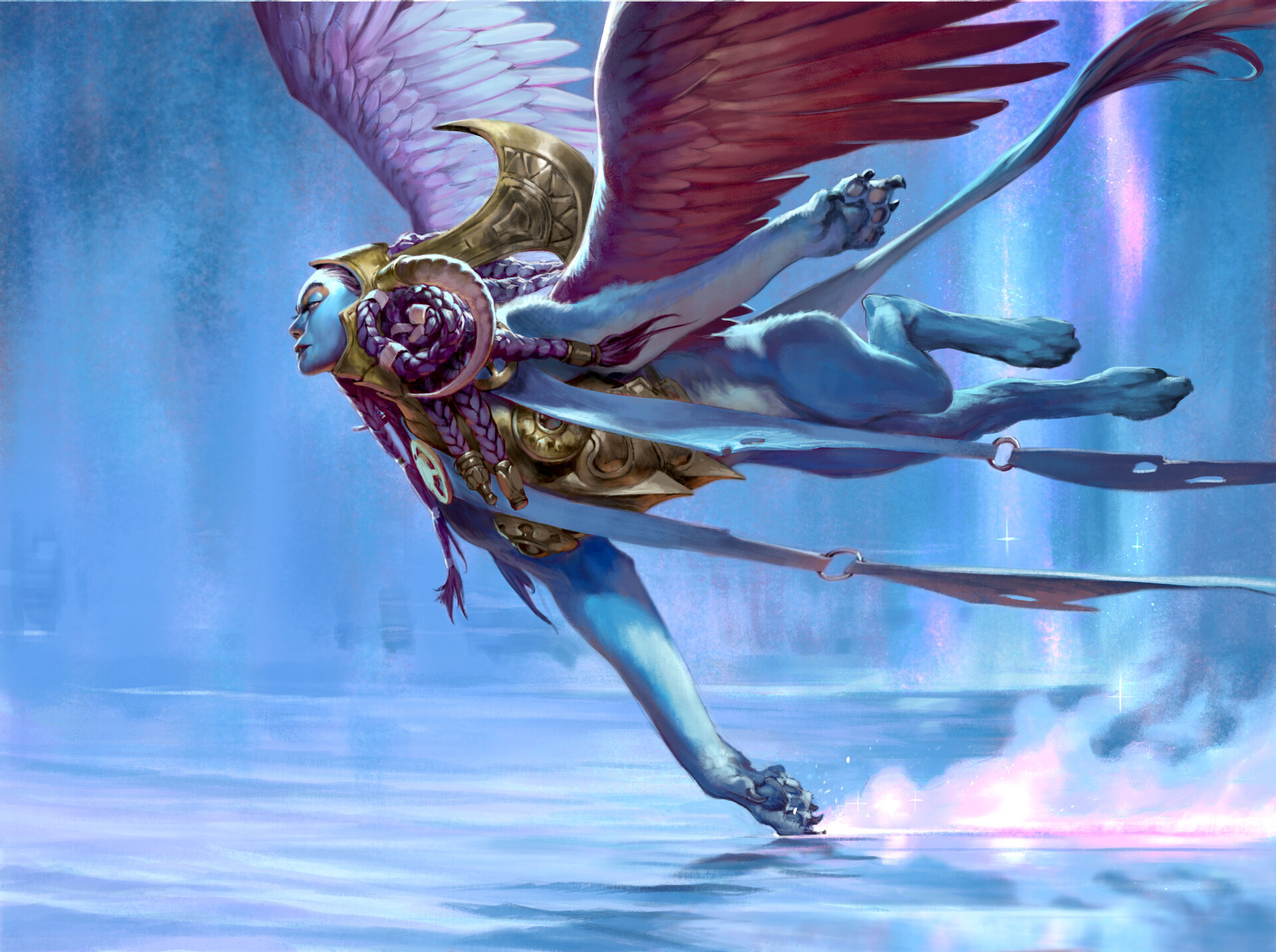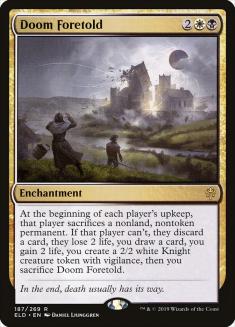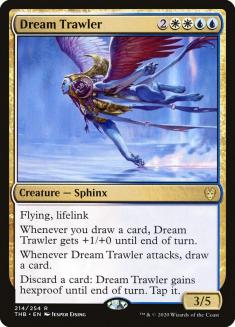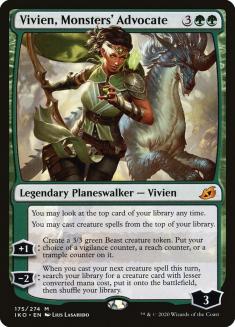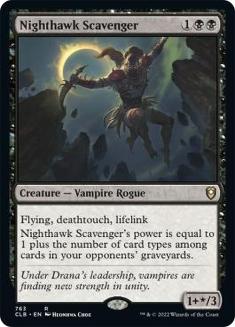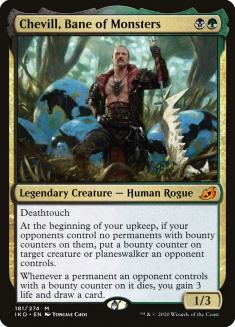Another month, another Standard ban.
At this point it’s become cliche. Each recent ban has brought with it the hope that it will be the one to finally bring about a fun, balanced Standard environment only to fall short, so I understand anyone who remains skeptical about the future of the format. But for the first time, we have a ban where it’s not immediately obvious what card(s) to look to next to dominate the metagame.
For the last year Standard has been ruled by a succession of incredibly powerful threats that are nigh-impossible to profitably interact with as well as efficient, low-risk sources of fast mana. Once Field of the Dead got the axe, we moved on to Oko, Thief of Crowns. Then there were Fires of Invention; Wilderness Reclamation; Uro, Titan of Nature’s Wrath; and Omnath, Locus of Creation. But all of these cards are gone now, as well as other offenders like Growth Spiral and Nissa, Who Shakes the World.
Wizards of the Coast (WotC) even tossed Lucky Clover and Escape to the Wilds out for good measure. It’s clear that they’re as tired of ramp’s dominance as the rest of us.
I’m sure plenty of people will immediately latch on to one of the decks that saw a modicum of success in the face of Omnath, like Gruul Adventures or Rakdos Midrange, but if we’re really moving past the ramp era, then the format is likely to undergo a fundamental shift. The rules of engagement will change and that will unlock a whole host of new cards and strategies that simply couldn’t compete in the pre-ban metagame.
That’s why I’m not worried about Embercleave dominating the format, because even though it was likely the third-best card in the previous metagame, the gameplan to beat it — lots of cheap, instant-speed removal — is easy to execute. The problem was that reactive decks struggled to contain Four-Color Adventures. The format itself was dominated by Lucky Clover and Omnath, and Embercleave was the best card at closing games before their powerful engine came online.
So rather than look at which decks survive the ban, I want to look at some cards that haven’t seen much play recently, but have the potential to break out in a big way should Standard return to normalcy.
Doom Foretold
If you like to play long games, Doom Foretold is the card for you. No card in Zendikar Rising Standard is better at controlling your opponent’s battlefield over multiple turns, and by the time its work is done, this enchantment absolutely dominates the game. The problem is that Doom Foretold works at its own pace. You need to extend the game in order to reap the rewards.
With cards like Escape to the Wilds enabled by Omnath around, Doom Foretold wasn’t fast enough to compete. Your opponents could set up turns where they put ten or more permanents on the battlefield, and even though Doom Foretold promises to clean it all up eventually, Omnath and friends would close the game long before that. But under more normalized circumstances, Doom Foretold is a powerful build-around, and many of the tools that deck plays as part of its engine, such as Omen of the Sea, Omen of the Sun, and Treacherous Blessing, look a lot more appealing in this new era.
I particularly like Doom Foretold in the early days of the new metagame because that’s when aggro is going to be disproportionately represented, preying on untuned lists. Doom Foretold decks have historically been great against aggro decks and I don’t see that stopping even if they no longer have access to Oath of Kaya. They have plenty of cheap interaction and the card advantage generated from Doom Foretold and Yorion, Sky Nomad is easily enough to take over the game.
I could even see leaning hard into Dance of the Manse again as an end-game haymaker. The ramp decks got to their end-game too quickly for a card like Dance to be effective, but with more time to set up and churn through your deck, it’ll be a great card to build around again.
I expect we’ll see a lot more classic attrition battles in Zendikar Rising Standard with the ramp decks out of the way, and those are the kinds of games that Doom Foretold wants to be in. The card is powerful enough that it has remained fringe-playable even in an unfavorable metagame, and its prospects will only improve from here.
Dream Trawler
Dream Trawler is another haymaker that fell on hard times because the ramp deck went so far over the top of it. With The Birth of Meletis and Dream Trawler, Azorius Control decks are naturally slanted toward playing a tap-out style rather than draw-go, but that style looked embarrassing when you tapped out for your big threat only to watch your opponent cast Genesis Ultimatum into Ugin, the Spirit Dragon or a ten-point Explosion. Simply put, Dream Trawler wasn’t powerful enough to want to tap out for, except in aggressive matchups.
And much like Doom Foretold, that shouldn’t be the case in the emerging Standard metagame. Dream Trawler is going to rule the roost most of the time you cast it, and for a creature as difficult to answer as Dream Trawler, that means a lot.
I’m high enough on casting Dream Trawler that I’d look to pair it with Solemn Simulacrum, which curves naturally into it while providing card advantage, a blocker against aggro, and mana fixing for a potential splash color. You’re going to want to play some counterspells, but you no longer have to live in fear of Omnath or Wilderness Reclamation creating an insurmountable advantage on Turn 4, so you can more confidently tap out in the early- and mid-game and use your counterspells to either trade on-curve or protect an advantageous position. You actually have time to set up now rather than being forced to end the game as quickly as possible or start answering your opponent’s threats on Turn 2 or 3.
Big-mana strategies and overpowered threats have completely pushed midrange and control finishers like Dream Trawler out of the format in 2020, but historically cards like these define the metagame. I expect them to do so once again and Dream Trawler may just be the best in its class.
Vivien, Monsters’ Advocate
My VS Live! co-host, Corey Baumeister, has been calling this card for a breakout performance for months now. Omnath ended that call by continuing ramp’s dominance, but it should come around now. It’s been a sideboard card for green decks against heavy removal strategies, but against ramp that stream of 3/3s didn’t end the game quickly enough, nor did it dominate the battlefield.
As the metagame gets more interactive, Vivien’s stock rises considerably. I expect it to at the very least rise from mediocre sideboard card to all-star sideboard card, but it’s powerful enough that I’d be trying it in maindecks. When your opponents are trying to contain your battlefield with removal and counterspells instead of ignoring your card advantage and going over the top, sticking a Vivien will quickly overwhelm them.
With cards like Kazandu Mammoth and Tangled Florahedron, you can even push your creature count significantly higher so you’ll more consistently gain card advantage with Vivien’s static. Even in a midrange strategy that plays more removal, pairing Vivien with Adventure creatures will push that creature count higher and let you gain some much-needed card advantage. So Vivien isn’t just a curve topper for aggro decks — it can perform in multiple strategies.
Standard used to be defined by versatile cards enabling flexible decks that could be aggro one game and control the next. Sideboarding against these decks was incredibly difficult, and you had to be prepared to win in multiple different ways. Ramp decks pushed all that out because they were too powerful, and with those strategies went versatile threats like Vivien, replaced by cards that ended the game faster. But as we go back to that old world and players are packing their decks with interaction, you want the versatile threats, not the vulnerable game-enders.
Nighthawk Scavenger
Nighthawk Scavenger represents another class of card that was devalued in the ramp-centric metagames of the past year: combat-dominating creatures. Despite having many aggro decks around combatting the ramp strategies, combat hasn’t been a significant part of Standard. Most of the time you’re either racing or the attacking player has such an advantage that the defending player has no good blocks.
As a result, creatures with combat-centric abilities were devalued in favor of creatures with a higher damage output for the mana. Nighthawk Scavenger even needs you to put some work into filling your opponent’s graveyard with removal, discard, or mill effects, so it didn’t fit in those metagames.
A more normalized metagame will have plenty of decks that want to take advantage of Nighthawk Scavenger’s unique set of skills. It’s a house against aggro, letting you ignore their early creatures while potentially trading later for a larger threat. It can also let midrange decks turn the corner easily with its evasion and lifelink. It may not draw cards or make mana, but Nighthawk Scavenger can easily take over a game.
The question for Nighthawk Scavenger will be how easily it can be answered. Importantly it survives Stomp and trades up on mana for a kicked Bloodchief’s Thirst. It also matches up well against Primal Might. But a metagame full of Scorching Dragonfires and Heartless Acts could make life tough for the Vampire Rogue. When Scavenger matches up poorly against the commonly played removal, it may top out as an anti-aggro sideboard card, but when it’s well-positioned, it’ll be on my short list of cards to play that weekend.
Chevill, Bane of Monsters
Last on the list is Chevill, Bane of Monsters. As a one-power creature for two mana, it wasn’t aggressive enough to race ramp decks. Chevill wants to play a longer game so you can draw some cards with its ability, but that kind of marginal card advantage was easily trumped by Uro or Genesis Ultimatum. This is a midrange card through and through. It mostly plays defense but can pressure a planeswalker when necessary. It’ll draw you a card or two and gain some life but rarely will it take over a game. And when it trades for a creature or removal spell, you’ll almost always end up ahead on mana in the exchange.
That may not sound like a ringing endorsement, but for a low investment of two mana, Chevill does a lot. It just doesn’t do a whole lot against decks that have inevitability. The ramp decks forced you to interact with them to some extent, but if you tried to interact too much, they would eventually whittle down your defenses to nothing.
Chevill excels in fair games, however, where its efficiency and versatility shine. Consider the following list:
Creatures (17)
- 3 Scavenging Ooze
- 2 Murderous Rider
- 3 Questing Beast
- 1 Polukranos, Unchained
- 3 Chevill, Bane of Monsters
- 4 Grakmaw, Skyclave Ravager
- 1 Nullpriest of Oblivion
Planeswalkers (5)
Lands (22)
Spells (16)

This is the kind of classic midrange strategy that I expect to see in Standard again: plenty of removal, lots of card advantage, and enough creatures to get aggressive when necessary. Unsurprisingly, this list incorporates a lot of the cards I’ve written about today, since decks like these have been most suppressed by the proliferation of ramp decks over the last year. And the Soul Shatters in the sideboard are mostly a nod to Dream Trawler, which is definitely a problem card.
The creature count here is a bit low for Vivien, but you don’t need to draw a ton of cards with its static ability for it to be effective. Without cards like Uro that win the game by themselves, you need to rely on multiple sources of card advantage, which this deck does with various planeswalkers, Chevill, and Grakmaw.
The removal suite is built around the most versatile answers in Bloodchief’s Thirst and Mythos of Nethroi, with the narrower but more powerful spells peppered in as wanted. Ultimately those flex spells will be customized to the given metagame.
I’m excited to return to the days when flexible threats and interaction combined to create a diverse, dynamic metagame, instead of the deformed metagames we’ve had where everything starts with how to build around the broken cards and which strategies can even contend with them. Such broken formats are often narrow because so many cards can’t match up with the top deck, so it’ll be important to revisit cards like the ones I’ve listed here and reevaluate the entire format from the ground up.
This feels a lot like preview season, where everything is new and untested. Abandon the preconceived notions you have about the cards in Zendikar Rising Standard, because it’s a whole new world out there.

